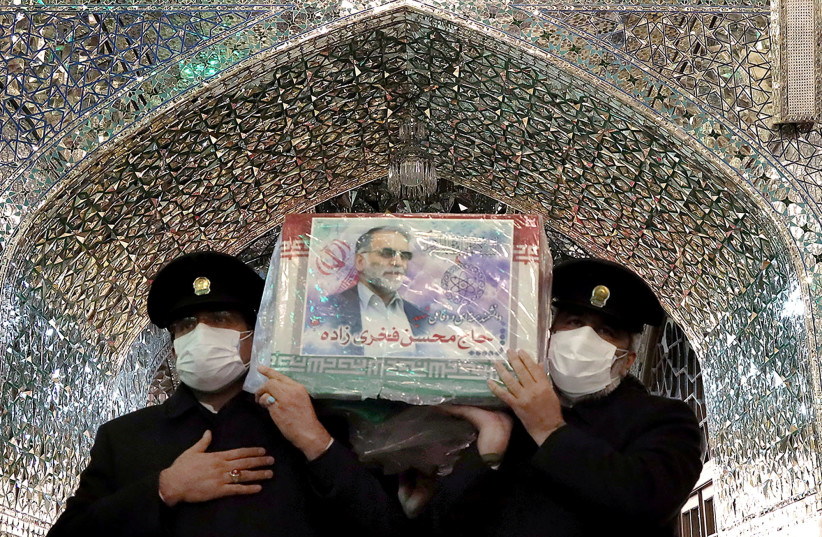Three theories, and we’ll never really know the truth.

Remote-controlled weapons killed Iranian nuclear scientist, key nuclear program chief Mohsen Fakhrizadeh, according to Iranian accounts. But, another account has it differently: a handful of assassins did it. Yet a third explanation has is that twelve men came with several vehicles, using one to blow up and block the security convoy that was protecting the high value target.
The competing narratives over the killing of the man who was at the pinnacle of Iran’s nuclear industrial complex is befitting one who was anyway known to be in the spotlight. Since the 2000s he was known to the US, sanctioned and then highlighted by a UN nuclear watchdog in 2011, before being named in a speech by Prime Minister Benjamin Netanyahu. You don’t get better known in Iran than that. The UN, the US and the Israelis have all mentioned you. You can retire, or travel with security, but you’re on the wanted list. So Mr. Fakhrizadeh knew that and those around him knew that. They knew that colleagues such as IRGC Quds Force head Qasem Soleimani had a deadly meeting with an American missile after travelling to Baghdad in January 2020. On the other hand, Iran also knew that attempted assassinations had been called off in the past for high value targets. They had something else. Just days before, on November 14, the world had learned that Al-Qaeda’s number two had been killed in Tehran.
How many assassin teams can possibly be operating in Tehran? That killing got international attention. It was carried out in August. Foreign reports claimed Israel did it in cooperation with the US.
Thus the Fars News story of the exact details of how Fakhrizadeh was killed are a bit too much information. He was driving home with his wife. A nice Friday afternoon. His convoy had three cars. They were driving near Absard to a nice house for the weekend. The cars slowed for some reason, maybe a security check. One kept going and then Fakhrizadeh’s car struck something. He got out and there a Nissan truck with a remote-controlled weapon in the back, sort of like the 1997 film The Jackal. Several bullets hit Fakhrizadeh. As he lay wounded and dying the truck exploded, also remotely. Only three minutes had passed. That would have been a lifetime for his guards in the two other cars and his wife. He was dead.
A second version, posted online under the name Abu Ali, claims to present another version from Iranian sources. In this estimation the hit-squad included 12 personnel. They had military training equivalent to special forces outside Iran.
More than 50 people supported their operation, maybe manning drones or satellites, or driving logistical support or moving weapons. The final assassination involved a Hyundai Santa Fe jeep, a Nissan pickup, and four motorcycles.
The assault squad used a Hyundai Santa Fe jeep, a Nissan pickup truck (which was trapped – AA) and 4 motorcycles. The Hyundai Santa Fe can actually be rented in Tehran with an extra cost of around 28 Euros to return it to the Imam Khomeini Airport. An extra driver costs another 10 Euros. In the case of an assassination, one definitely needs to get the full coverage, collision and personal protect. Deductible is another 900 Euros in this case.
According to these sources, the story is that the Iranian nuke chief was on his way to a private village. The hit team cut the power to the area and waited for the convoy to arrive. They deployed two snipers and four members of the team with the jeep. As the convoy passed, the first security vehicle continued on. At this moment the Nissan blew up to stop the convoy. Then, the members of the assassination team poured gunfire into
Fakhrizadeh’s car and the security vehicle. The nuclear chief was even pulled out and shot, to make sure he was dead. The security details of the trip were known beforehand via some sort of cyber hack.
Some details of the story seem comparable. In both the Nissan truck appears. In both it explodes. The difference is that in one account a large number of other vehicles and shooters were present. Is it reasonable to conclude that an entire assassination would be done remotely with a rifle mounted in a truck, like in a movie? Clearly if one wanted to actually succeed, and not have the rifle jam or the truck to be uncovered, that be risky. Why go to such lengths to find and eliminate such an important person and leave it up to chance that some kind of signal might jam and the rifle malfunction. On the other hand, four motorcycles and two extra vehicles running around parts of Iran might be a bit large of a presence.
As reported by The Jerusalem Post
